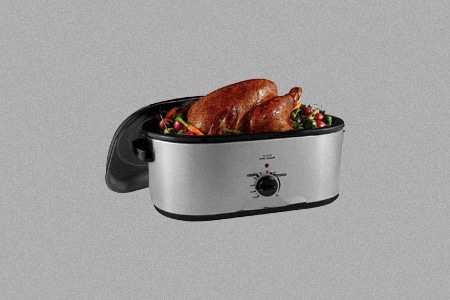13 Types of Ovens Perfectly Suited for Your Kitchen's Needs
Author: Anne Cowart | Editor: Omar Alonso
Review & Research: Jen Worst & Chris Miller

An oven is the cornerstone of any household, where most of the cooking is done, right from your cakes, cookies, Sunday roasts to pizza and lots more. And, without any of the types of ovens your kitchen is incomplete.
An oven is a must-have appliance for any kitchen; however, before you go shopping for one, it is necessary to have a good idea of which type of oven is best for your cooking and baking purposes.
Finding the perfect oven for your kitchen can be quite a challenge, especially with loads of types, brands and models that are available. Choosing the right oven is important to get the best results from it.
13 Types of Ovens
So, to make your decision-making easier, we have shortlisted the different types of ovens that will suit your purposes, regardless of whether you’re a professional or a novice.
Gas Oven

Gas ovens have been around for many decades and are very popular options in many homes. These ovens make use of gas as the power source and the burning gas creates the heat for the gas oven.
These oven types are much cheaper to operate compared to their electric counterparts as they heat up to the required temperature more quickly. They also cool down very quickly when turned off and cook food uniformly so that there are no hotspots that will burn portions of your food.
However, the newer apartment blocks and buildings don’t use gas for safety reasons and it is also quite expensive to get a gas line installed. While gas ovens may be expensive to purchase, they offer more savings in the long run.
And, while gas ovens may not bake or cook food as well as an electric oven, people still prefer gas ovens because they retain moisture well, making them more suitable for roasting. Gas ovens also allow you to set the temperature and control your cooking better.
Electric Oven

If you’re on the lookout for a reliable oven that’s not as expensive as a gas oven, then you could consider an electric oven. The savings will let you pick up all the new types of pots you can use in the oven.
These are quite popular because they are easy to operate and clean, they are quite cheap and suitable for all types of cooking. Your electric oven will start heating instantly with just a turn of the knob, although it may take longer to heat.
Since there is no single heating source, electric types of ovens produce more uniform heat, which makes them excellent for baking.
Also, since electric ovens produce dry heat, they are very good for roasting and if you want extra moisture, then you can do this by spritzing the food with water or adding a pan of water. However, running an electric oven can mean higher electricity bills.
Electric ovens can be further categorized into conduction ovens and convection ovens, and the difference between the two is in the way the oven heats up the air.
Conventional Oven

This is likely the oven you're most familiar with. They can come as gas ovens or electric ovens, because it's not the heat source that defines it so much as the shape. The conventional oven features one door with an electric stovetop seated above it.
Everything is managed by dials on a face plate at an easy to reach height in the kitchen. You'll control the stove options as well as the oven options, including baking or broiling among other choices as well as the temperature and timer settings.
Conventional types of ovens have heating elements typically at the bottom with two or three adjustable height racks. The heat rises up and then radiates throughout the oven cavity by bouncing off of the walls.
This attempts to heat your food evenly from all sides like giant dutch oven substitutes although the reality is less perfect than it sounds. Using higher racks tends to deliver more heat due to the heat rising and staying higher up within the oven.
Convection Oven

A convection oven, sometimes called a conduction oven, is equipped with a fan that helps to ensure uniform distribution of hot air within the oven, which means that there will not be too many hot or cold spots and the food will be cooked and even browned evenly.
Commercial convection ovens are more powerful compared to conventional ovens and can heat the food easily and evenly regardless of where you place it. Also, these ovens run a bit cooler, which means that the oven will not wear out faster and will be more long lasting.
However, one of the main drawbacks of convection ovens is that the fan needs a motor to work and if the motor fails, the oven will not work properly.
Also, since the cooking times are shorter and temperatures are different in a convection oven, cooking with it will require a little practice compared to a conventional conduction oven.
Steam Oven

In recent years, steam ovens have become quite popular and an excellent alternative for homeowners looking for healthy, nutritious and delicious food.
Steam ovens are water-based ovens that work by using a separate canister or connection to a water line to inject water into the boiler, which creates steam and heats the oven.
The steam types of ovens create a moist cooking environment in the oven and also reduces the amount of oil used when cooking, making it a healthier alternative.
However, if you want your food to be crispy, then a steam oven may not be the best option because the amount of steam in the oven keeps the food moist inside. But even if you're cooking with oven-safe types of pans, you can still wrap the tops in tin foil to stop this.
But, cooking in a steam oven can reduce the cooking time, help your food retain more nutrients and be more flavorful. The only downside to steam ovens is that they are more expensive compared to gas and electric ovens.
Microwave Oven

These are essentially electric ovens that make use of electromagnetic waves to heat food. The food particles start vibrating and the friction produces heat. These oven alternatives are in almost every home now, even in apartments.
While microwave ovens are mostly used to reheat food, these days, the newer microwave models allow you to do a lot more. These ovens are very energy efficient and quick; however, they may not be suitable for cooking tasks like browning or roasting.
Wall-Mounted Oven

Instead of a mounting an oven underneath or within the countertop within a kitchen (called a silde-in oven or a drop-in oven), these are built into the walls so they "technically" don't eat up any more floor space.
Often there will be two stacked on top of each other, and take up about the same space as a most types of refrigerators, due to how elevated the ovens are from the ground. These different types of ovens are a great luxury if you can squeeze them into your kitchen.
Roaster Oven

If you have a lot of space in your kitchen, then you could consider a roaster oven, which is great for steaming, roasting or slow cooking.
Many homes have a roaster oven types especially for roasting meat, which helps to free up the main oven for other dishes. While a roaster oven may not be an alternative to a full-fledged oven, it can be a great addition to your kitchen.
Pizza Oven

If you love pizzas, then a regular oven will not provide the temperature required for a crispy crust. Pizza ovens are specially designed ovens that can reach much higher temperatures and give your pizza base the extra crispiness you love.
Usually, pizza ovens are large in size and may not fit into your kitchen and may be more suitable for installation outdoors, in restaurants or in commercial kitchens.
You can buy a smaller oven to fit into your kitchen; however, for the best pizza experience, it is better to purchase a dedicated pizza oven and set it up in your backyard. Just like a kitchen oven, don't put cardboard in these ovens either.
Self-Cleaning Oven

There is no denying the convenience of an oven; however, cleaning one can be quite a tedious, cumbersome and time-consuming task, especially with all that burnt food, grease, oil, etc.
Fortunately, today, there are self-cleaning oven models available, which is a super-handy function; making cleaning the oven very quick and easy. However, this feature may not be available in all models.
Self-cleaning ovens can be classified into catalytic and pyrolytic ovens. Catalytic ovens are usually lined with special types of chemicals that absorb all the food spilled in the oven, making cleaning up much easier.
On the other hand, pyrolytic ovens heat up to around 500 degrees and burn up any food residues completely and all you need to do is sweep out the ashes.
Of the two types, pyrolytic ovens are more common. The only drawback of self-cleaning ovens is that because the leftover food is burned, it produces a lot of smoke, which can cause eye irritation and also set off your fire alarm.
Single Oven

These are the most common types of ovens available and are designed to fit anywhere in your kitchen, whether at eye level or below your kitchen counter.
A single oven lets you cook foods at a single temperature. And, the best part is that they don’t take up a lot of space and so, are perfect for smaller sized kitchens.
Single ovens are sturdy and reliable, having fewer parts so you don’t have to worry about them failing or breaking. And, if you have a small family or don’t use an oven very often, then a single oven is perfect for most of your cooking needs.
Double Oven

If you have a larger family, host large parties, or like to cook in bulk, then a double oven is a great option for you. Essentially, a double oven is two single ovens that are stacked one on top of the other.
The advantages of double oven types are that you can cook two different kinds of dishes at different temperatures or you can use one to cook, while using the other oven to grill, roast, bake, etc.
You can either purchase a double oven, where both ovens are the same size or if you don’t have sufficient space in your kitchen, then you can opt for one that is smaller than the other.
Also, some double ovens come with the option of one conventional oven and one convection. So, you can buy a double oven depending on your cooking requirements.
Freestanding Oven

These are very easy to find and quite popular too. You can install a freestanding oven anywhere in your kitchen and if you have the right kind of outlets, you can move the oven anywhere you want.
Generally, freestanding ovens come with a cooktop on the oven (which is one of the types of stoves), so that you don’t need to find additional space for your cooktop.
However, the only drawback of this model is that you need to bend down often to access the food, which can be quite tedious at times.
Types of Ovens for Every Kitchen
So, this brings us to the end of the article on the different types of ovens. We hope that this information helps you to make a smart oven purchase.
The ovens we have discussed in our article are the most basic types of ovens and there are other rare models available on the market that are just variations of the ones above with extra features such as heating drawers, storage drawers, delay bake, proof mode, Wi-Fi, etc.




